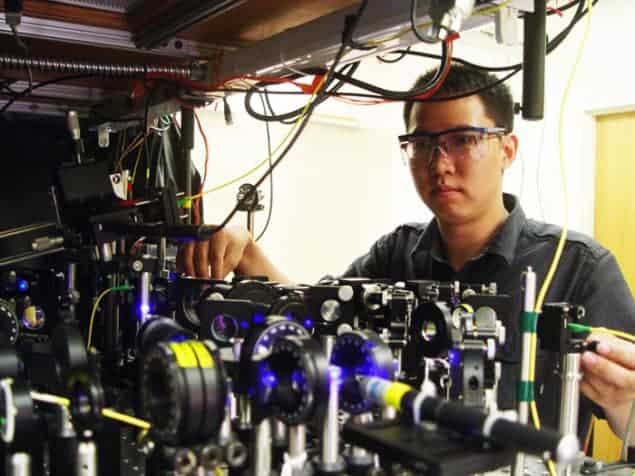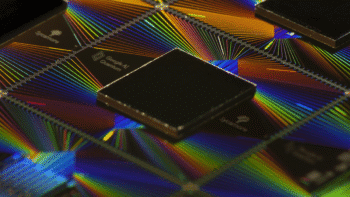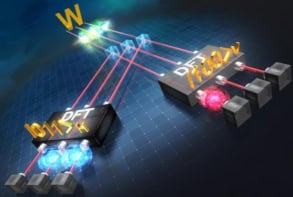
The first system that can produce atom–photon entangled pairs on demand has been built by physicists in the US. The set-up uses a 1D optical lattice of ultracold atoms to emit a single photon. However, unlike previous experiments, in which the quantum state of the atoms is destroyed immediately after photon emission, the atomic state endures and is entangled with the photon. Another important feature of the system is that it is deterministic, producing entangled states on demand. Together, these properties could be exploited to create networks for processing and distributing quantum information.
Entanglement is a purely quantum-mechanical phenomenon that allows two particles to have a much closer relationship than is allowed by classical physics. This relationship can be exploited in quantum-information systems and physicists are keen to create entangled systems that could be used in practical applications. In particular, researchers would like to entangle optical photons – which can carry quantum information over hundreds of kilometres – with stable stationary quantum bits (qubits) such as trapped atoms. The problem, however, is that it can be very difficult to get photons to interact with such stationary qubits in a reliable way.
Blockaded atoms
Rydberg states in ensembles of ultracold atoms offer a way forward because these highly excited states interact very strongly with light. They are much like a Rydberg atom, in which one electron is promoted to a very high energy state. However, in this case the electron is not associated with one specific atom but rather with the entire ensemble. Thanks to an effect called the “Rydberg excitation blockade”, only one Rydberg state at a time can occur in the ensemble, which ensures that only a single photon is emitted or absorbed.
While physicists had previously been able to store and emit photons using Rydberg states, any entanglement did not endure in the atoms for long enough to be measured. Now, Alex Kuzmich and colleagues at the Georgia Institute of Technology have come up with a way to entangle photons and Rydberg states for relatively long periods of time.
The experiment begins by cooling a gas of rubidium-87 atoms to microkelvin temperatures. A laser field is then switched on to create a 1D optical lattice containing about 500 atoms in a line. This ensemble is then placed in a collective Rydberg state by zapping it with laser pulses. More pulses are then fired at the ensemble to produce an entangled state of a photon and a “spin-wave” state that remains in the atomic ensemble.
The phase of the emitted photon is then measured. To confirm that the photon is entangled with the atomic ensemble, more pulses are fired at the atoms, causing them to emit a second photon that is characteristic of the spin-wave state.
Phase correlations
The phase of this second photon is measured and by repeating this process many times, the correlation between the phases of the two photons is determined. The team found that the correlation is greater than that allowed by classical physics and therefore the photon and atomic ensemble are entangled.
By varying the delay between the emissions of the two photons, the team was able to work out how long the entanglement endured in the atomic ensemble – which the researchers calculate to be a few microseconds. While this does not sound long, it is enough to allow the photon to travel a few hundred metres, which means that several such atomic ensembles could be connected together in a lab to create a simple circuit for processing quantum information.
An important feature of the system is that the entanglement is deterministic – at least in principle. This means that the process would create an entangled pair every time if it could be implemented using a perfect experimental set-up. This is different to many other schemes for creating entanglement, which are inherently probabilistic and cannot deliver an entangled state every time. Another important feature of the system is that it can generate as many as 5000 entangled photons per second – a thousand times more than previous systems using Rydberg states.
Enabling quantum networks
Together, these features suggest that several such sources could be connected to create a multinode network for processing quantum information. “Such atom–light entanglement might be useful for future work on the realization of distributed quantum systems, which may be applied to quantum communication, computation or similar tasks,” says Kuzmich.
Charles Adams of Durham University in the UK describes the work as “groundbreaking” and “a key advance towards the realization of a quantum network”.
Kuzmich and colleagues are now working on ways to improve the trap used to hold the atoms, which should increase the time for which the entanglement endures.
The experiment is described in Nature.



